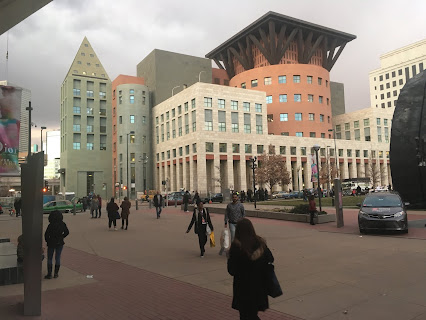 |
| Queensland, Australia - rural environments have unique transport challenges |
by Tarah Hodgkinson
A few weeks ago, I had the opportunity to chat with folks living in one of Northern Queensland’s islands in Australia. While speaking to local Indigenous leaders and community members about safety and liveability, I was struck by one particular issue they raised: transportation.
Over the years we have posted many blogs on urban transportation and how it enhances liveability, including some creative innovations in the harshest climates. This time the story emerged from rural environments. I heard that it was often difficult for residents to find transportation to attend health care appointments, pick up groceries, visit with friends, and attend local events. Typical public transit such as buses or trains were not an option, because the population was small and very spread out.
 |
| Rail lines in the town of Roma, Australia |
First, in many of the rural communities I’ve worked with in recent years, I hear stories such as local kids unable to get to after-school activities or no access to basic health care and affordable food because they couldn’t get to their doctor or shops. In North Battleford, Canada, for example, clients of the local shelter explained that despite being able to get a ride into town for services, they were unable to find transportation home on the same day, leaving them stranded.
Second, this issue was particularly important for older individuals. When our team partnered with the huge non-profit AARP a few years ago to run a SafeGrowth Search Conference in New Orleans, we learned quickly that transportation issues restricted access to necessary services and raised issues of safety for vulnerable populations like the elderly.
Third, transportation issues also affect those living with disabilities. During my time with the Multiple Sclerosis Society of Canada, I learned that many of our clients lacked accessible transportation, aside from a bi-weekly accessibility bus, leaving them isolated and unable to leave the house.
TRANSPORT POVERTY
Often called transport poverty, the inability to access affordable and reliable transportation can result in a number of social issues. For a once-rural kid like myself, it often meant a lack of opportunities to engage in extracurriculars that offer pathways for success. Transport poverty also leaves many individuals feeling isolated and unable to engage in their community - one of the essential quality of life messages in 3rd Generation CPTED.
In some locations, informal networks emerge to create solutions to this issue. In the Australian town of Roma, Queensland, a local Indigenous elder spent most of her day driving local kids around to meetings and to school.
At the MS Society in Ontario, there was an informal network of volunteers and other support staff who offered rides and helped people get to appointments and other things they couldn’t do without the accessibility bus.
These stories are inspiring and remind us of the innovative and creative ways people come together to overcome issues in their neighbourhoods and communities. But there are more formal ways of making transportation easily accessible in order to allow people opportunities to build new networks and relationships and participate fully in their communities.
 |
| Decent sidewalks and bike lanes make a big difference |
For example, Demand Responsive Transit and Flexible Integrated Transport Systems offer a flexible and shared service that allows people who live near to each other to share transportation when buses or trains are not available or physically accessible. These systems allow users to pre-book transportation, meet at their home or nearby and travel to selected locations like shopping, health and community facilities or transportation hubs.
Essentially, it is like a big taxi for people in your area, but far more affordable by using a standard low fare (public transit focused) and can be easily accessed through phone technology like apps. These kinds of programs are used in parts of Europe and Australia.
Public transportation should be affordable and accessible to everyone. It allows us to connect and engage fully in our community, while also accessing services to improve our health and quality of life. And after a year of COVID-19 – it might be more important than ever.







